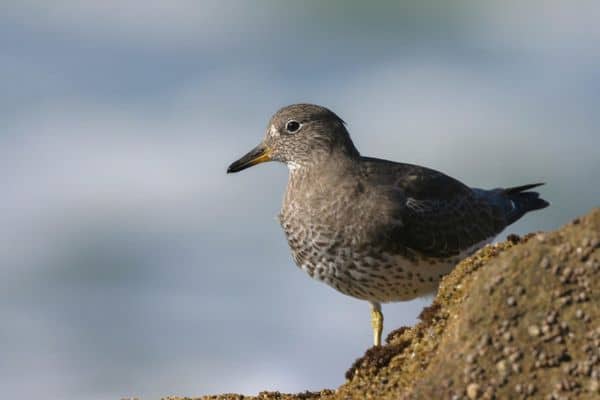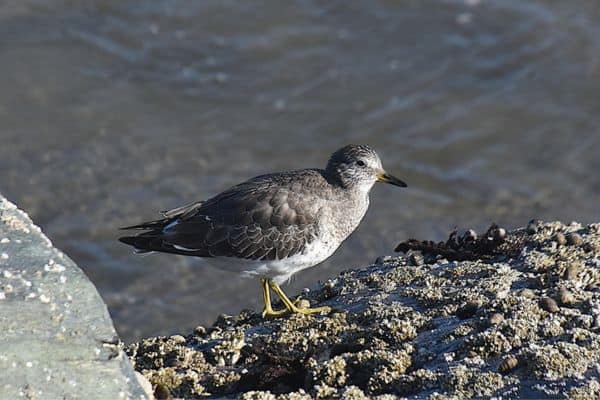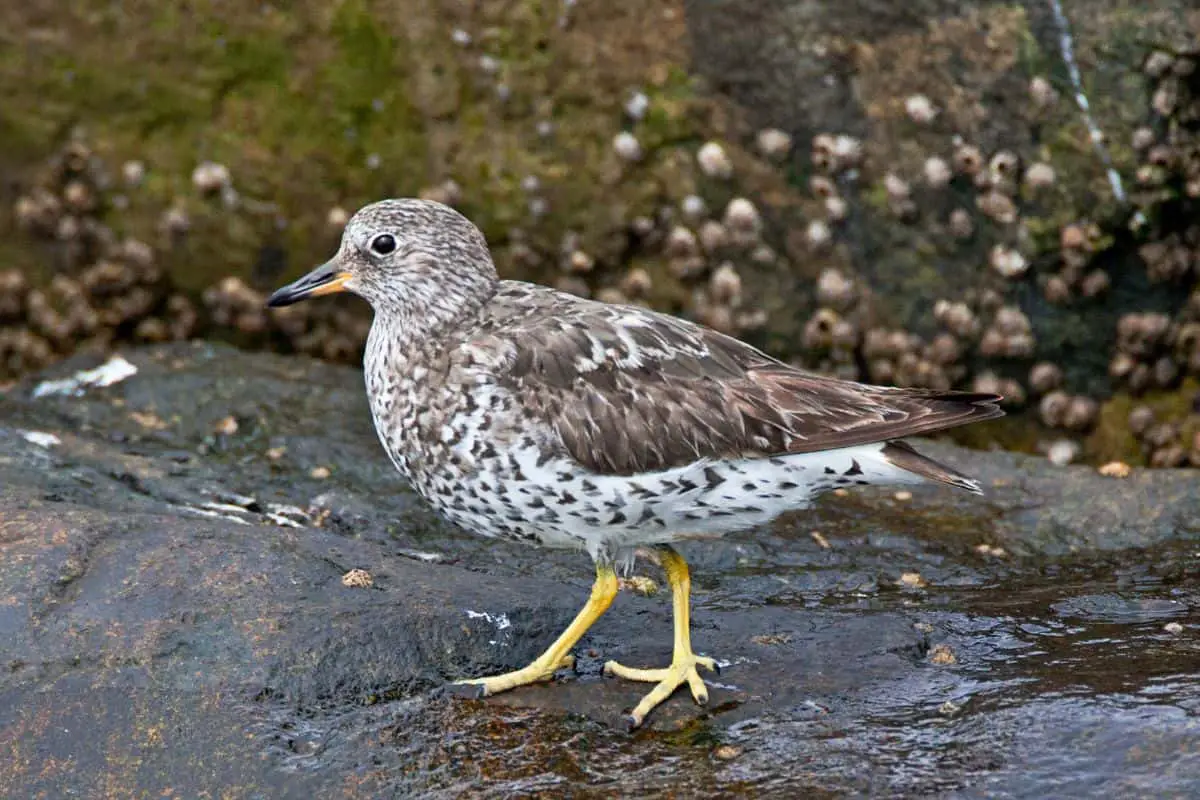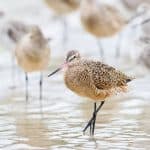Common Name: Surfbird
Scientific Name: Calidris virgata| Size | Diet | Range in Hawaii | Status in Hawaii |
|---|---|---|---|
| 8 in. - 9 in. | small crustaceans, mollusks, insects, marine worms | O'ahu | Least Concern |
The Surfbird (Calidris virgata) is a unique-looking shorebird with a distinctive black and white striped pattern on its wings and a bright orange beak. This bird species is a resident of rocky shorelines along the Pacific coast of North America, from Alaska to California.
Interestingly, the Surfbird has also been spotted in Hawaii, where it is a rare but occasional visitor to the islands. In this articlet, we’ll take a closer look at the Surfbird and explore its fascinating characteristics and behaviors, as well as its presence in the beautiful and diverse ecosystem of Hawaii.
Surfbird
Appearance

The Surfbird is a medium-sized shorebird with a distinctive appearance. It measures around 8 to 9 inches in length. It has a stocky build with a rounded body, short neck, and a relatively long, straight bill.
The plumage of the Surfbird is unique, featuring a mottled brown and black pattern on its upperparts, while the underparts are pale with streaks and bars. During the breeding season, the male Surfbird develops a dark rufous coloration on its head and chest, adding to its striking appearance.
Diet
The Surfbird has a diverse diet that primarily consists of invertebrates found along the shorelines and rocky intertidal zones. It forages for food by probing and pecking at the sand, rocks, and seaweed. Its diet includes small crustaceans, mollusks, insects, marine worms, and various other marine invertebrates.
The Surfbird is well-adapted to feed in challenging coastal environments, using its specialized bill to extract prey from crevices and to pick at algae-covered rocks. This species has a flexible feeding behavior and adjusts its diet based on the availability of food sources throughout its range.
Nesting
The Surfbird is a migratory bird species that breeds in the Arctic regions of Alaska and Canada. It typically nests on rocky slopes or cliffs near the coast, choosing sites that provide good visibility and protection from predators. The female Surfbird builds a simple nest on the ground, usually in a well-concealed location among rocks or vegetation.
The nest is a shallow depression lined with moss, lichens, and other soft materials. The female lays a clutch of 3-4 eggs, which are incubated by both parents for about three weeks. After hatching, the chicks are precocial, meaning they are relatively mature and mobile at birth.
They leave the nest shortly after hatching and start feeding themselves, although they may still receive some parental care and protection. The Surfbird’s nesting period is relatively short, as the birds must migrate to their wintering grounds in coastal areas of North and South America.
Behavior

The Surfbird is a fascinating bird known for its unique behaviors. It is highly adapted to its rocky coastal habitat. These birds are often seen foraging along the shoreline, probing into crevices and cracks with their specialized bills in search of invertebrates, such as insects, crustaceans, and mollusks. Surfbirds are also known for their agility and ability to navigate rocky terrain with ease, using their strong legs and sharp claws to grip onto rocks.
During the breeding season, Surfbirds engage in courtship displays, which may involve aerial displays, wing-fluttering, and vocalizations. Males may also engage in competitive behaviors to attract mates and establish territories. Once paired, the male and female work together to build a nest and share incubation duties.
Surfbirds are migratory birds, undertaking long-distance journeys between their breeding grounds in the Arctic and their wintering grounds in coastal areas of North and South America. They navigate these extensive migrations using their innate navigational abilities and landmarks.
These birds are social creatures and are often found in small flocks or mixed-species groups, especially during the non-breeding season. They communicate with each other through various vocalizations, including calls and alarm signals, to maintain group cohesion and warn of potential threats.
Habitat
The Surfbird is a bird species that is primarily found in rocky coastal habitats. It is well-adapted to the challenging environments characterized by rocky shores, cliffs, and boulder-strewn beaches. These habitats provide the Surfbirds with ample opportunities for foraging and shelter.
During the breeding season, Surfbirds typically nest in the Arctic tundra, specifically in the rocky areas near rivers and streams. The rocky terrain offers them protection from predators and serves as a suitable location for building nests. After the breeding season, Surfbirds migrate to their non-breeding grounds along the coastlines of North and South America, where they continue to inhabit rocky shores and intertidal zones.
These birds are often observed in close proximity to the ocean, where they feed on the various invertebrates that inhabit the intertidal zone, including barnacles, mollusks, and small crustaceans. The rocky habitats provide the Surfbirds with ample hiding spots, allowing them to blend in with their surroundings and evade potential predators.
The Surfbird’s habitat preference reflects its specialized adaptation to rocky coastal environments, making it a distinctive and well-suited species to thrive in these unique habitats.
Range
The Surfbird, primarily found in western Alaska and ranging from southeastern Alaska to Tierra del Fuego, has occasionally been sighted as a vagrant visitor along the Atlantic coast. In Hawaii, there is a single recorded instance of a Surfbird observed along the southeast coast of O’ahu.
This individual was present for an extended period from April to July 2012 and again in February to March 2013. Although it is believed to have arrived as a fall transient, it likely over-wintered and possibly even over-summered in Hawaii undetected. The sighting was accepted by the Hawaiian Bird Records Committee (HBRC) in September 2014, adding to the bird’s range in the Hawaiian Islands.
Conservation Status

The Surfbird currently has a conservation status of “Least Concern” according to the International Union for Conservation of Nature (IUCN). While specific population numbers are unknown, the species has a relatively wide distribution and is considered to have a stable population trend.
Surfbirds face various threats to their habitat and survival. Coastal development, including the construction of infrastructure and disturbance of nesting sites, can disrupt their breeding activities. Pollution and habitat degradation, such as oil spills and the presence of marine debris, also pose risks to their well-being.
Interesting Facts
1. Specialized foraging techniques
Surfbirds have specialized foraging techniques, probing their bills into rocky crevices to find invertebrates such as crustaceans, mollusks, and insects.
2. Highly adaptable species
They are highly adapted to withstand the harsh coastal environments, including exposure to crashing waves, strong winds, and rocky terrain.
3. Monogamous
Surfbirds exhibit monogamous mating behavior, with pairs typically remaining together for a breeding season.
4. High-elevation Nests
Surfbirds prefer nesting in the alpine and subalpine regions, choosing elevated rocky slopes as their breeding grounds.
5. Vocal communicators
Surfbirds use a variety of vocalizations, including short calls and trills, to communicate with their mates and defend their territories.
Frequently Asked Questions
1. Are Surfbirds social birds?
Surfbirds are generally gregarious and can be found in small to large flocks, especially during migration and in wintering areas. However, they also exhibit territorial behavior during the breeding season.
2. How long do Surfbirds typically live?
Surfbirds have a lifespan of around 10 to 15 years in the wild. However, with the right conditions and survival factors, some individuals have been known to live even longer.
3. Do Surfbirds have any predators?
Surfbirds face predation from various avian and mammalian predators. Their eggs and young are vulnerable to predation by gulls, crows, foxes, and other shorebird predators. However, their cryptic coloration and nesting behaviors help provide some protection.




